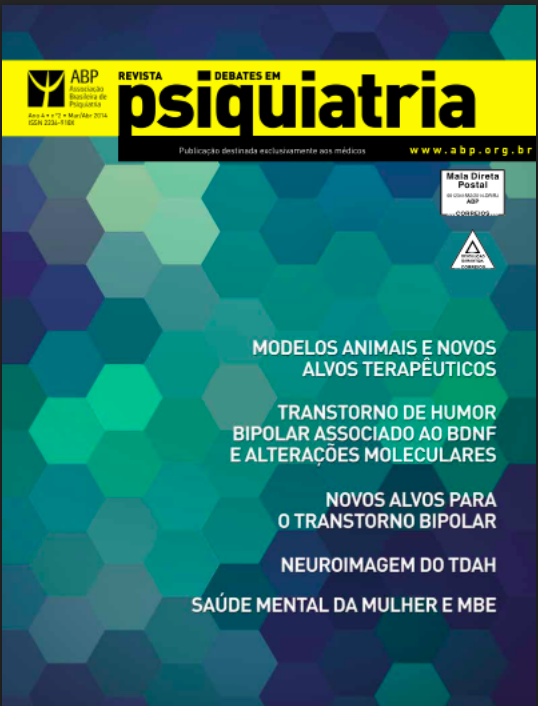Neuroimagem do TDAH: achados de ressonância magnética estrutural e funcional
DOI:
https://doi.org/10.25118/2763-9037.2014.v4.248Palabras clave:
TDAH, ressonância magnética estrutural, ressonância magnética funcional, rede cerebral padrão, conectividade funcional intrínseca, conectividade funcional em estado de repousoResumen
Essa revisão descreve primeiramente o funcionamento das metodologias de ressonância magnética: morfometria baseada em voxels, morfometria baseada em superfície, imagem por tensor de difusão, ressonância magnética funcional com aplicação de tarefas neuropsicológicas e sem tarefas, historicamente conhecida como ressonância funcional em estado de repouso. Em seguida, traz os principais achados da aplicação dessas técnicas no estudo do TDAH.
Descargas
Métricas
Citas
Matthews M, Nigg JT, Fair DA. Attention Deficit Hyperactivity Disorder. Curr Top Behav Neurosci. 2013;11.Epub ahead of print. https://doi.org/10.1007/978-3-662-45758-0_249 DOI: https://doi.org/10.1007/978-3-662-45758-0_249
Cortese S, Castellanos FX. Neuroimaging of attentiondeficit/hyperactivity disorder: current neuroscience-informed perspectives for clinicians. Curr Psychiatry Rep. 2012;14:568-78. https://doi.org/10.1007/s11920-012-0310-y DOI: https://doi.org/10.1007/s11920-012-0310-y
Valera EM, Faraone SV, Murray KE, Seidman LJ. Meta-analysis of structural imaging findings in attention-deficit/ hyperactivity disorder. Biol Psychiatry. 2007;61:1361-9. https://doi.org/10.1016/j.biopsych.2006.06.011 DOI: https://doi.org/10.1016/j.biopsych.2006.06.011
Ellison-Wright I, Ellison-Wright Z, Bullmore E. Structural brain change in ADHD identified by meta-analysis. BMC Psychiatry. 2008;8:1-8. https://doi.org/10.1186/1471-244X-8-51 DOI: https://doi.org/10.1186/1471-244X-8-51
Nakao T, Radua J, Rubia K, Mataix-Cols D. Gray Matter Volume Abnormalities in ADHD: Voxel-Based Meta-Analysis Exploring the Effects of Age and Stimulant Medication. Am J Psychiatry. 2011;168:1154-63. https://doi.org/10.1176/appi.ajp.2011.11020281 DOI: https://doi.org/10.1176/appi.ajp.2011.11020281
Sowell ER, Thompson PM, Welcome SE, Henkenius AL, Toga AW, Peterson BS. Cortical abnormalities in children and adolescents with attention-deficit hyperactivity disorder. Lancet. 2003;362:1699-707. https://doi.org/10.1016/S0140-6736(03)14842-8 DOI: https://doi.org/10.1016/S0140-6736(03)14842-8
Shaw P, Clasen L, Giedd J, Rapoport J. Longitudinal mapping of cortical thickness and clinical outcome in children and adolescents with attention-eficit/hyperactivity disorder. Arch Gen Psychiatry. 2006;63:540-9. https://doi.org/10.1001/archpsyc.63.5.540 DOI: https://doi.org/10.1001/archpsyc.63.5.540
Wolosin SM, Richardson ME, Hennessey JG, Denckla MB, Mostofsky SH. Abnormal cerebral cortex structure in children with ADHD. Hum Brain Mapp. 2009;30:175-84. https://doi.org/10.1002/hbm.20496 DOI: https://doi.org/10.1002/hbm.20496
Narr KL, Woods RP, Lin J, et al. Widespread cortical thinning is a robust anatomical marker for attention-deficit/ hyperactivity disorder. J Am Acad Child Adolesc Psychiatry. 2009;48:1014-22. https://doi.org/10.1097/CHI.0b013e3181b395c0 DOI: https://doi.org/10.1097/CHI.0b013e3181b395c0
Shaw P, Eckstrand K, Lerch JP, Greenstein D, ClasenL. Attention-deficit/hyperactivity disorder is characterized by a dealy in cortical maturation. PNAS. 2007:1-6.
Shaw P, Gornick M, Lerch J, et al. Polymorphisms of the dopamine D4 receptor, clinical outcome, and cortical structure in attention-deficit/hyperactivity disorder. Arch Gen Psychiatry. 2007;64:921-31. https://doi.org/10.1001/archpsyc.64.8.921 DOI: https://doi.org/10.1001/archpsyc.64.8.921
Ivanov I, Bansal R, Hao X, et al. Morphological abnormalities of the thalamus in youths with attention deficit hyperactivity disorder. Am J Psychiatry. 2010;167:397-408. https://doi.org/10.1176/appi.ajp.2009.09030398 DOI: https://doi.org/10.1176/appi.ajp.2009.09030398
Ashtari M, Kumra S, Bhaskar SL, et al. Attention-deficit/ hyperactivity disorder: a preliminary diffusion tensor imaging study. Biol Psychiatry. 2005;57:448-55. https://doi.org/10.1016/j.biopsych.2004.11.047 DOI: https://doi.org/10.1016/j.biopsych.2004.11.047
Casey BJ, Epstein JN, Buhle J, et al. Frontostriatal connectivity and its role in cognitive control in parent-child dyads with ADHD. Am J Psychiatry. 2007;164:1729-36. https://doi.org/10.1176/appi.ajp.2007.06101754 DOI: https://doi.org/10.1176/appi.ajp.2007.06101754
Hamilton LS, Levitt JG, O'Neill J, et al. Reduced white matter integrity in attention-deficit hyperactivity disorder. Neuroreport. 2008;19:1705-8. https://doi.org/10.1097/WNR.0b013e3283174415 DOI: https://doi.org/10.1097/WNR.0b013e3283174415
Cao Q, Sun L, Gong G, et al. The macrostructural and microstructural abnormalities of corpus callosum in children with attention deficit/hyperactivity disorder: A combined morphometric and diffusion tensor MRI study. Brain Res. 2010;1310:172-180. https://doi.org/10.1016/j.brainres.2009.10.031 DOI: https://doi.org/10.1016/j.brainres.2009.10.031
Kobel M, Bechtel N, Specht K, et al. Structural and functional imaging approaches in attention deficit/hyperactivity disorder: does the temporal lobe play a key role? Psychiatry Res. 2010;183:230-6. https://doi.org/10.1016/j.pscychresns.2010.03.010 DOI: https://doi.org/10.1016/j.pscychresns.2010.03.010
Davenport ND, Karatekin C, White T, Lim KO. Differential fractional anisotropy abnormalities in adolescents with ADHD or schizophrenia. Psychiatry Res. 2010;181:193-8. https://doi.org/10.1016/j.pscychresns.2009.10.012 DOI: https://doi.org/10.1016/j.pscychresns.2009.10.012
Konrad K, Eickhoff SB. Is the ADHD brain wired differently? A review on structural and functional connectivity in attention deficit hyperactivity disorder. Hum Brain Mapp. 2010;31:904-16. https://doi.org/10.1002/hbm.21058 DOI: https://doi.org/10.1002/hbm.21058
Ogawa S, Lee TM, Kay AR, Tank DW. Brain magnetic resonance imaging with contrast dependent on blood oxygenation. Proc Natl Acad Sci USA. 1990;87:9868-72. https://doi.org/10.1073/pnas.87.24.9868 DOI: https://doi.org/10.1073/pnas.87.24.9868
Dickstein SG, Bannon K, Milham MP. The neural correlates of attention deficit hyperactivity disorder: an ALE meta-analysis. J Child Psychol Psychiatry. 2006;47:1051-62. https://doi.org/10.1111/j.1469-7610.2006.01671.x DOI: https://doi.org/10.1111/j.1469-7610.2006.01671.x
Buckner RL, Andrews-Hanna JR, Schacter DL. The brain's default network: anatomy, function, and relevance to disease. Ann N Y Acad Sci. 2008;1124:1-38. https://doi.org/10.1196/annals.1440.011 DOI: https://doi.org/10.1196/annals.1440.011
Sonuga-Barke EJS, Castellanos FX. Spontaneous attentional fluctuations in impaired states and pathologicalconditions: a neurobiological hypothesis. Neurosci Biobehav Rev. 2007;31:977-86. https://doi.org/10.1016/j.neubiorev.2007.02.005 DOI: https://doi.org/10.1016/j.neubiorev.2007.02.005
Lin P, Sun J, Yu G, et al. Global and local brain network reorganization in attention-deficit/hyperactivity disorder. Brain Imaging and Behavior. 2013;11.Epub ahead of print. 25. Fair DA, Posner J, Nagel BJ, et al. Atypical default network connectivity in youth with attention-deficit/hyperactivity disorder. Biol Psychiatry. 2010;68:1084-91. https://doi.org/10.1016/j.biopsych.2010.07.003 DOI: https://doi.org/10.1016/j.biopsych.2010.07.003
Castellanos FX, Margulies DS, Kelly C, et al. Cingulate-precuneus interactions: a new locus of dysfunction in adult attention-deficit/hyperactivity disorder. Biol Psychiatry. 2008;63:332-7. https://doi.org/10.1016/j.biopsych.2007.06.025 DOI: https://doi.org/10.1016/j.biopsych.2007.06.025
Rubia K, Halari R, Mohammad A-M, Taylor E, Brammer M. Methylphenidate normalizes frontocingulate underactivation during error processing in attention-deficit/hyperactivity disorder. Biol Psychiatry. 2011;70:255-62. https://doi.org/10.1016/j.biopsych.2011.04.018 DOI: https://doi.org/10.1016/j.biopsych.2011.04.018
Nooner KB, Colcombe SJ, Tobe RH, et al. The NKIRockland Sample: A Model for Accelerating the Pace of Discovery Science in Psychiatry. Front Neurosci. 2012;6:152. https://doi.org/10.3389/fnins.2012.00152 DOI: https://doi.org/10.3389/fnins.2012.00152
Descargas
Publicado
Cómo citar
Número
Sección
Licencia
Derechos de autor 2014 Felipe Almeida Picon

Esta obra está bajo una licencia internacional Creative Commons Atribución-NoComercial 4.0.
Debates em Psiquiatria permite que el (los) autor (es) mantenga(n) sus derechos de autor sin restricciones. Permite al (los) autor (es) conservar sus derechos de publicación sin restricciones. Los autores deben garantizar que el artículo es un trabajo original sin fabricación, fraude o plagio; no infringe ningún derecho de autor o derecho de propiedad de terceros. Los autores también deben garantizar que cada uno atendió a los requisitos de autoría conforme a la recomendación del ICMJE y entienden que, si el artículo o parte de él es fallido o fraudulento, cada autor comparte la responsabilidad.
Reconocimiento-NoComercial 4.0 internacional (CC BY-NC 4.0) - Debates em Psiquiatria es regida por la licencia CC-BY-NC
Usted es libre de:
- Compartir — copiar y redistribuir el material en cualquier medio o formato
- Adaptar — remezclar, transformar y crear a partir del material
El licenciador no puede revocar estas libertades mientras cumpla con los términos de la licencia. Bajo las condiciones siguientes:
- Reconocimiento — Debe reconocer adecuadamente la autoría, proporcionar un enlace a la licencia e indicar si se han realizado cambios<. Puede hacerlo de cualquier manera razonable, pero no de una manera que sugiera que tiene el apoyo del licenciador o lo recibe por el uso que hace.
- NoComercial — No puede utilizar el material para una finalidad comercial.
No hay restricciones adicionales — No puede aplicar términos legales o medidas tecnológicas que legalmente restrinjan realizar aquello que la licencia permite.




























